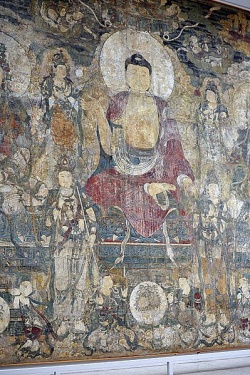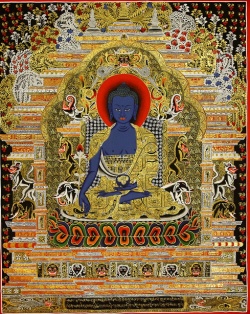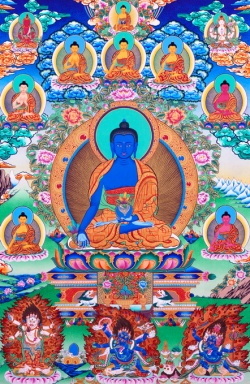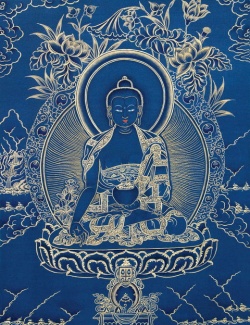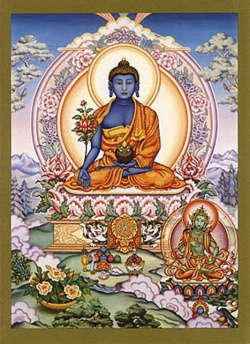Bhaisajyaguru
Click here to see other articles relating to word Bhaisajyaguru
- See also :
- See also :
Bhaiṣajyaguru (भैषज्यगुरु), formally Bhaiṣajyaguruvaiḍūryaprabhārāja (भैषज्यगुरुवैडूर्यप्रभाराज, "Medicine Master and King of Lapis Lazuli Light"), is the buddha of healing and medicine in Mahāyāna Buddhism. Commonly referred to as the "Medicine Buddha", he is described as a doctor who cures suffering using the medicine of his teachings.
Origin
Bhaiṣajyaguru is described in the eponymous Bhaiṣajyaguruvaiḍūryaprabhārāja Sūtra (भैषज्यगुरुवैडूर्यप्रभाराज सूत्र), commonly called the Medicine Buddha Sutra, as a bodhisattva who made 12 great vows. On achieving Buddhahood, he became the Buddha of the eastern realm of Vaiḍūryanirbhāsa (वैडूर्यनिर्भास), or "Pure Lapis Lazuli". There, he is attended to by two bodhisattvas symbolizing the light of the sun and the light of the moon respectively:
- Suryaprabha (Chinese: 日光遍照菩薩; pinyin: rìguāng biànzhào púsà)
- Candraprabha (Chinese: 月光遍照菩薩; pinyin: yuèguāng biànzhào púsà)
A Sanskrit manuscript of the Bhaiṣajyaguruvaiḍūryaprabhārāja Sūtra was among the textual finds at Gilgit, Pakistan, attesting to the popularity of Bhaiṣajyaguru in the ancient northwest Indian kingdom of Gandhāra. The manuscripts in this find are dated before the 7th century, and are written in the upright Gupta script.
The Chinese Buddhist monk Xuanzang visited a Mahāsāṃghika monastery at Bamiyan, Afghanistan, in the 7th century CE, and the site of this monastery has been rediscovered by archaeologists. Birchbark manuscript fragments from several Mahāyāna sūtras have been discovered at the site, including the Bhaiṣajyaguruvaidūryaprabharāja Sūtra (MS 2385).
The Twelve Vows
The Twelve Vows of the Medicine Buddha upon attaining Enlightenment, according to the Medicine Buddha Sutra are:
- 1.To illuminate countless realms with his radiance, enabling anyone to become a Buddha just like him.
- 2.To awaken the minds of sentient beings through his light of lapis lazuli.
- 3.To provide the sentient beings with whatever material needs they require.
Dharani and Mantra
In the Bhaiṣajyaguruvaiḍūryaprabhārāja Sūtra, the Medicine Buddha is described as having entered into a state of samadhi called "Eliminating All the Suffering and Afflictions of Sentient Beings." From this samadhi state he spoke the Medicine Buddha Dharani.
- namo bhagavate bhaiṣajyaguru vaiḍūryaprabharājāya tathāgatāya arhate samyaksambuddhāya tadyathā:
oṃ bhaiṣajye bhaiṣajye mahābhaiṣajya-samudgate svāhā.
The last line of the dharani is used as Bhaisajyaguru's short form mantra. There are several other mantras for the Medicine Buddha as well that are used in different schools of Vajrayana Buddhism.
Iconography
Bhaiṣajyaguru is typically depicted seated, wearing the three robes of a Buddhist monk, holding a lapis-colored jar of medicine nectar in his left hand and the right hand resting on his right knee, holding the stem of the Aruna fruit or Myrobalan between thumb and forefinger. In the sutra, he is also described by his aura of lapis lazuli-colored light. In Chinese depictions, he is sometimes holding a pagoda, symbolising the ten thousand Buddhas of the three periods of time. He is also depicted standing on a Northern Wei stele from approximately 500 AD now housed in the Metropolitan Museum of Art, accompanied by his two attendants, Suryaprabha and Candraprabha. Within the halo are depicted the Seven Bhaiṣajyaguru Buddhas and seven apsaras.
Role in Chinese Buddhism
The practice of veneration of the Medicine Buddha is also popular in China, as he is depicted as one of the trinity of Buddhas, the others being the founder Śākyamuni and Amitabha. He can also be viewed as the healing attribution to Śākyamuni, as he is often called the "Medicine King" in sutras. There are two popular Chinese translations of this sutra:
one by Xuanzang and the other by Yijing both translated in the Tang Dynasty.
The Taisho Tripitaka and Qianlong Tripitaka (Chinese: 乾隆大藏經) each have three translations of the sutra:
- 1.By Dharmagupta in 615 CE (Taisho: vol. 14, no. 449; Qianlong: no. 166)
These three versions have different titles:
- Chinese: 藥師琉璃光七佛本願功德經 (no. 168, two scrolls).
The version translated by Yijing includes not only the vows of the Medicine Buddha but also the vows of the Seven Past Buddhas.
Like Tibetan Buddhists, Chinese Buddhists recite the mantra of the Medicine Buddha to overcome mental, physical and spiritual sickness. The Bhaiṣajyaguruvaiḍūryaprabhārāja Sūtra, which the Medicine Buddha is associated with and described in great detail in, is a common sutra to recite in Chinese temples as well. Furthermore, much like the nianfo path of Amitabha, the name of Medicine Buddha is also recited for the benefit of being reborn in the Eastern Pure Lands, though this is deemphasized in favor of the Medicine Buddha's role for the living.
Role in Japanese Buddhism
Starting in the 7th century in Japan, Yakushi was prayed to in the place of Ashuku (Akshobhya). Some of Yakushi's role has been taken over by Jizō (Ksitigarbha), but Yakushi is still invoked in the traditional memorial services for the dead.
Older temples, those mostly found in the Tendai and Shingon sects, especially those around Kyoto, Nara and the Kinki region often have Yakushi as the center of devotion, unlike later Buddhist sects which focus on Amitabha Buddha or Kannon Bodhisattva almost exclusively. Often, when Yakushi is the center of devotion in a Buddhist temple, he is flanked by the Twelve Heavenly Generals (十二神将 Jūni-shinshō?), who were twelve yaksha generals who had been converted through hearing the Bhaiṣajyaguruvaiḍūryaprabhārāja Sūtra:
Wherever this sutra circulates or wherever there are sentient beings who hold fast to the name of the Medicine Buddha Yakushi Buddha and respectfully make offerings to him, whether in villages, towns, kingdoms or in the wilderness, we [the Twelve Generals] will all protect them. We will release them from all suffering and calamities and see to it that all their wishes are fulfilled.
Role in Tibetan Buddhism
The practice of Medicine Buddha, the Supreme Healer (or Sangye Menla in Tibetan) is not only a very powerful method for healing and increasing healing powers both for oneself and others, but also for overcoming the inner sickness of attachment, hatred, and ignorance, thus to meditate on the Medicine Buddha can help decrease physical and mental illness and suffering.
The Medicine Buddha mantra is held to be extremely powerful for healing of physical illnesses and purification of negative karma. One form of practice based on the Medicine Buddha is done when one is stricken by disease. The patient is
to recite the long Medicine Buddha mantra 108 times over a glass of water. The water is now believed to be blessed by the power of the mantra and the blessing of the Medicine Buddha himself, and the patient is to drink the water. This practice is then repeated each day until the illness is cured.
